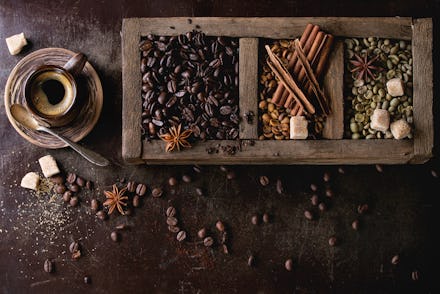What you can learn from ancient coffee rituals around the world

For many caffeine lovers, coffee drinking is less of a habit and more of a sacred ritual. In fact, the history of coffee rituals around the world is an intimate view into the lives of coffee drinkers who came before us.
If you trace coffee back to its place of origin — Ethiopia — you’ll discover that the drink was prepared as part of a ceremony, which included herbs and spices that passed energy and health to its drinker.
People have always wondered about the health benefits of coffee, but it wasn’t until the 19th century that someone thought to use health benefits as a way to market the drink. Grocery entrepreneur John Arbuckle married the scientific evidence of coffee’s health benefits with advertising, which propelled Arbuckle to become the dominant coffee company in the United States in the late 19th century.
Today, studies provide conflicting evidence about coffee’s health effects — but its cultural effect is undeniable. A look at three ancient rituals reveals that past societies, too, saw drinking coffee as a beneficial pastime for various reasons.
Ethiopia
In the birthplace of coffee, the Ethiopian coffee ceremony — which can occur multiple times a day — is the main social event of a village. Coffee and water are the primary ingredients, but depending on the location, people may add in spices.
Traditionally, women roast the green coffee beans in a pan over an open flame, right before eager guests’ eyes. Next, the beans are ground in a wooden mortar with a pestle. These grounds are then crushed with a heavy metal rod called zenezena in a metal bowl, called a mukecha, before brewing. The grinds are boiled with hot water in a decorated container, often a clay pot, known as a jebena. Cardamom, cinnamon and cloves are often added to the coffee as it begins to crack upon roasting.
Cinnamon spice, commonly used in traditional medicine, is a high source of antioxidants. It also protects heart health and brain function.
Clove, the aromatic flower bud and spice, aids in maintaining a strong immune system, smooth digestion and a healthy liver. Upon the addition of cinnamon and clove, the coffee is accompanied by roasted barley, amasha bread, peanuts or popcorn.
To serve up the sentiment of Ethiopia’s ancient coffee rituals at home, host a group of friends and serve tons of coffee — the brew should flow as smoothly as the great conversation.
India
India is the sixth largest coffee producer in the world. Legend has it that 400 years ago, a saint named Baba Budan brought magical beans from Yemen, planting them in the Chadragiri hills of Karnataka. Coffee and spice have been intimate partners for a while, given that many coffee plantations in India grow spices as well.
And while turmeric milk, or “haldi doodh,” is a drink that’s coffee-free, it’s deeply steeped in varying rituals across India. The “golden milk” is often prepared fresh: whisked coconut milk, turmeric, ginger, honey, coconut oil, peppercorns and a cup of water are brought to a warm temperature and then allowed to sit for 10 minutes. Often dubbed a cure-all spice, turmeric is believed to be good for the common cold as an anti-inflammatory and an antioxidant in ayurvedic medicine. Traditionally turmeric lattes are consumed at night to help with insomnia and inflammation.
Searches for turmeric increased by more than 300% in 2015; the vibrant drinks are a health trend that’s swiftly caught on in the West, making its way into specialty coffee cafes and wellness storefronts.
To honor the tradition, try your hand at a traditional recipe made in your own kitchen.
Arabian Peninsula
In Saudi Arabia, coffee started out as a drink for mystics. Sufi mystics across the Arabian peninsula felt coffee enhanced their concentration and the depth of their spiritual connection with God. Yemenis gave coffee an Arabic name: qahwa.
Water, coffee and cardamom were the key ingredients in a beverage that fueled the intellectual thought of the gathered mystics. Cardamon is believed to aid in digestion and waste elimination. To make qahwa, coffee is added to water and left to boil for approximately 10 minutes. Then crushed cardamom and pinches of saffron are added to the beverage for flavoring and left to steep.
Today, one of the most popular and important coffee species cultivated, arabica, gets its name from this area. Arabica grew in the highlands before its eventual spread into Egypt and before becoming a dominant beverage in Europe in the 16th and 17th centuries.
Broaden your spice rack and purchase a container of cardamom to add a little history to your cup of joe.